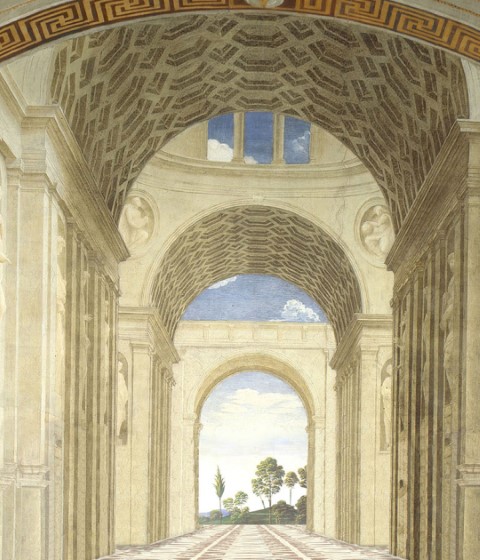In the exhibition, curators Xristina Argyros and Ryan Neiheiser from the London-based practice Neiheiser Argyros have responded to the theme of “Freespace” set by Yvonne Farrell and Shelly McNamara by treating academic common spaces as architectural specimens — identified, categorised, and made available for analysis and comparison. Mounted on vertical steel bars, these models will be organized in a grid that will fill the pavilion equally in all directions, categorised by time, typology, scale, and spatial strategy.
The models reveal the communal spaces within each university as part of an international student collaboration between the Architectural Association in London and the National Technical University of Athens. Academic institutions included in the exhibition range from Plato’s Academy of Athens, the Carpenter Center by Le Corbusier, the ‘Infinite Corridor’ at MIT in Cambridge, The University of Cambridge courtyards, and the voids of SANAA’s Rolex Learning Centre, among others.
The project recognises that common spaces within the university – unprogrammed spaces for impromptu conversation, casual gossip, heated debate, pop-up lectures, networking, and informal teaching – are vital to the institution’s continued relevance and vibrancy.
By constructing a stepped landscape, the pavilion space becomes a 21stcentury School of Athens, reinforcing the social and collaborative theme of the exhibition, whilst also enabling individuals to learn and host informal conversations and lectures. The 3D printed models are displayed across the landscape, inviting visitors to move throughout the pavilion with the guidance of a map and a detailed catalogue, thus transforming them into active participants.
The models reveal the communal spaces within each university as part of an international student collaboration between the Architectural Association in London and the National Technical University of Athens. Academic institutions included in the exhibition range from Plato’s Academy of Athens, the Carpenter Center by Le Corbusier, the ‘Infinite Corridor’ at MIT in Cambridge, The University of Cambridge courtyards, and the voids of SANAA’s Rolex Learning Centre, among others.
The project recognises that common spaces within the university – unprogrammed spaces for impromptu conversation, casual gossip, heated debate, pop-up lectures, networking, and informal teaching – are vital to the institution’s continued relevance and vibrancy.
By constructing a stepped landscape, the pavilion space becomes a 21stcentury School of Athens, reinforcing the social and collaborative theme of the exhibition, whilst also enabling individuals to learn and host informal conversations and lectures. The 3D printed models are displayed across the landscape, inviting visitors to move throughout the pavilion with the guidance of a map and a detailed catalogue, thus transforming them into active participants.
“The School of Athens is an ambition; a utopian vision of a free, open, informal, and common space for learning. It is an in-between space. Neither inside nor outside, not quite a room, but also not simply a space for circulation. Although we typically think of learning taking place in the classroom, educators and architects have recognised for thousands of years that learning also takes place in the space between; in the hallways, on the stairs, at the café, in the quad,” says Ryan Neiheiser, co-curator and co-founder at Neiheiser Argyros.
Xristina Argyros, co-curator and co-founder at Neiheiser Argyros adds: “The ambition is to both look back, and to scan across the current landscape of university architecture, to extract compelling and successful spaces that are free - democratic, unprogrammed, and common."
As part of the exhibition, a symposium on the history, present, and possible future of the academic commons will take place at the National Pavilion of Greece on Saturday, 26th May 2018 from 12:30 – 6:00 pm. Each speaker will present a single project that addresses the theme of the exhibition, “The School of Athens”.
The curators, Ryan Neiheiser and Xristina Argyros, have invited an internationally recognized group of speakers who will discuss their vision for the pedagogical function that academic buildings play in our society. Speakers will include Liz Diller, John Tuomey and Sheila O'Donnell, Marion Weiss and Michael Manfredi, Eva Franch, Franklin Azzi, Joseph Grima, Jean Pierre Barclay and Sandra Crousse, Stefano Graziani with Francesco Zuddas, Alison Brooks, and Eelco Hooftman.
Some of the questions that will be addressed include: What is the space of the academic commons? How can an academic common be fostered and nurtured? What are the architectural characteristics of the academic commons?
Following the opening symposium, a series of events will continue throughout the summer and fall– with notable experts from across Greece engaging with leading thinkers from around the world.
The School of Athens is commissioned by The Greek Ministry of Environment and Energy and the Secretary General of Spatial Planning and Urban Environment, Eirini Klampatsea.
The curators, Ryan Neiheiser and Xristina Argyros, have invited an internationally recognized group of speakers who will discuss their vision for the pedagogical function that academic buildings play in our society. Speakers will include Liz Diller, John Tuomey and Sheila O'Donnell, Marion Weiss and Michael Manfredi, Eva Franch, Franklin Azzi, Joseph Grima, Jean Pierre Barclay and Sandra Crousse, Stefano Graziani with Francesco Zuddas, Alison Brooks, and Eelco Hooftman.
Some of the questions that will be addressed include: What is the space of the academic commons? How can an academic common be fostered and nurtured? What are the architectural characteristics of the academic commons?
Following the opening symposium, a series of events will continue throughout the summer and fall– with notable experts from across Greece engaging with leading thinkers from around the world.
The School of Athens is commissioned by The Greek Ministry of Environment and Energy and the Secretary General of Spatial Planning and Urban Environment, Eirini Klampatsea.








































